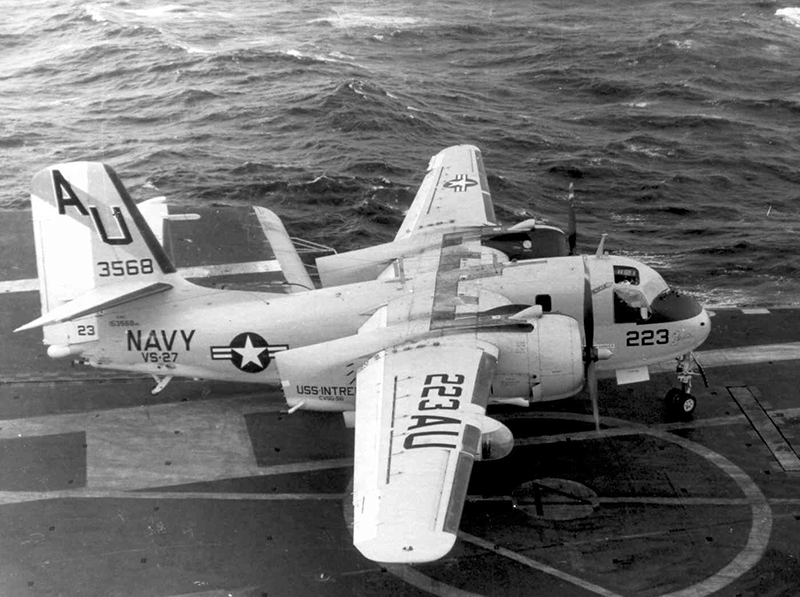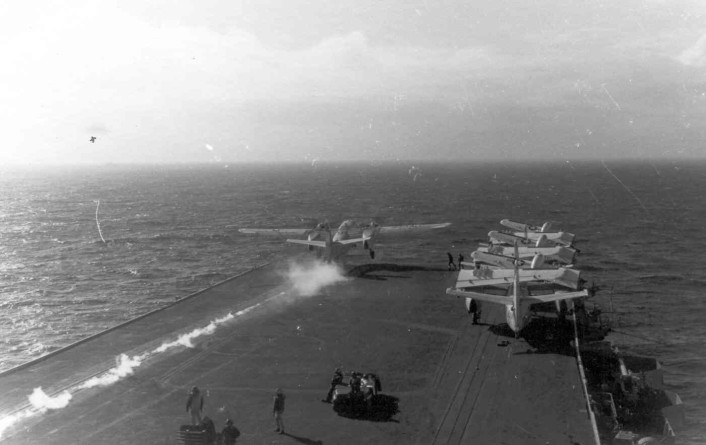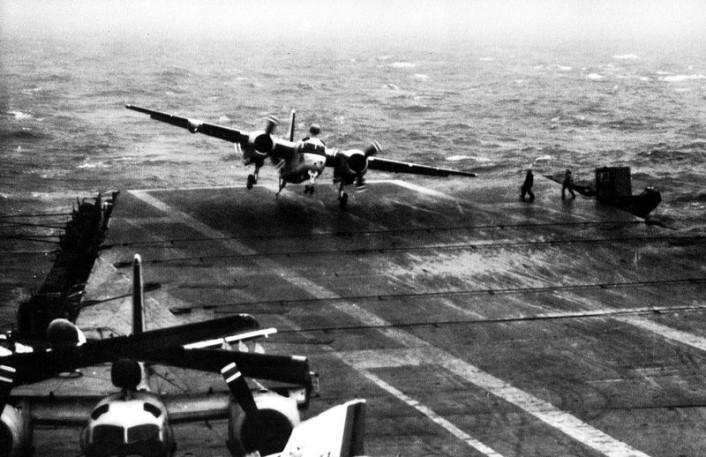Flying a US Navy S-2 single engine to the beach while the ship was begging it to come back aboard.
“Jimmy, how you doing?” Jack shook my hand. We were in the Reno, Nevada hotel meeting room that would serve as our reunion headquarters for the next three days. Whenever I hear Jack come into sight, he always says the same thing: “Jimmy, how you doing?” No one else that I know ever calls me “Jimmy”, but Jack always uses that diminutive for some reason. Not that I mind it – after all, that is what most people called me through high school. I cannot see Jack or hear his familiar voice call me Jimmy without thinking about one night forty years earlier in September, 1972, a night that is seared into my brain forever.
We both sit down, I give Jack a bottle of cold beer, and go through the old ritual of getting out my old dark blue Navy pilot’s flight log book and thumbing through the drying and yellowing pages. We do this every reunion. There it is, September 26th. The line entry in the logbook is written in red ink. A flight in a Stoof, the unofficial name for an S-2G “Tracker”, Bureau Number 152811, 5.8 hours total flight time, 4 hours of night time, 4 hours of actual instrument conditions, and an actual radar approach and landing in Bodø, Norway. And it shows that Jack and I flew together on that dark and stormy evening. Suddenly, I am no longer in a Reno hotel room but instead north of the Arctic Circle over the Norwegian Sea in our twin engine carrier-based Navy aircraft.
****
“Jimmy, let’s climb up and get some altitude.” As soon as I advanced the throttles, there was a series of loud bangs and milder pops. Then the cockpit filled with flashes of light, white smoke, and the smell of burned aviation gasoline and oil. I looked at the red lit gauges in the dark cockpit and saw that the port engine tachometer was falling off, showing that it was not developing full power. I instinctively throttled back the left engine until the popping stopped and turned the aircraft east towards the nearest land and a safe long runway ashore. “Jack, I’m headed to the beach” and I turned the aircraft to the east.
Jack, sitting in the right seat as co-pilot, was senior in rank to me and actually pilot in command of the flight. That meant that Jack would be making all official decisions during the flight. Both of us were fully qualified aircraft commanders and we had been scheduled together so that Jack could conduct my annual instrument check. I was sitting in the left seat and performing first pilot duties while Jack in the right seat acted as co-pilot although really in charge.
Jack radioed USS Intrepid (CVS-11): “We have a rough running port engine and are headed to the beach.” After a slight pause, the air controller replied: “Negative, return to the ship for a landing. Your signal is Charlie 30” (indicating that we should expect to land in about thirty minutes). Despite my instincts, I turned back in the rain and dark towards the west and the aircraft carrier. We were given radar vectors and then told to hold until the flight deck was cleared of other aircraft so that we could make a landing.
Image credit: Jim Tritten
New and even louder bangs and pops filled our eardrums and the cockpit once again filled with flashes of light, acrid smells, and white smoke. Both of us flinched in our seats and involuntarily took in sudden breaths. Then without any actions by either of us, one tremendous “BANG” caused the whole aircraft to shudder as yellow and red flames shot out the front of the port engine through the slowly rotating propeller. “Shit” we both said as we looked out the left side. I pulled back and to the right on the controls as the aircraft pitched down and yawed to the left. Engine sounds diminished and blue flames out of the exhaust stacks died completely. Our speed slowed and the altimeter began to unwind. I increased rudder pressure on the right rudder pedal as the aircraft’s remaining engine responded to my throttle movements forward to generate more power that would keep us in the air.
“Jack, we’ve lost number one and I have to feather it.”
Since Jack was legally in charge, I did not automatically feather the propeller but instead informed him that is what we needed to do while I awaited his concurrence. Making a decision to feather a windmilling propeller attached to a dead engine was a no brainer. Without moving the propeller blades into a streamlined position, and by doing so reducing the drag, we would descend and eventually hit the water. Jack and I both agreed on which of the two engines was causing the problem and which button would feather the dead prop. I pushed the correct [left] red feather button, causing the three propeller blades to align themselves with the wind stream so that we could maintain altitude and airspeed.
“Jack, I think we ought to go to the beach.”
Without waiting for a reply, I turned the yoke to bank the aircraft again the second time towards the east. We had taken off from the ship a little over an hour before. When our Stoof was catapulted into the air, the 872 foot long gray aircraft carrier had been pitching and rolling with white foam coming over the bow with spray hitting the aircraft parked behind the island amidships. After we had taken off, the sun had set and a cold front had moved in, further agitating the ocean. Steady rain now fully obscured the moon and stars. Outside of the cockpit everything was gray.
Jack radioed the ship: “We’ve lost the port engine and are headed towards the beach.” The ship replied with a “Roger.” I jettisoned the aircraft’s ordnance load to lighten the aircraft and calculated roughly how long it was going to take us to get to the closest divert airfield – Bodø, Norway – about two and a half hours east with a tailwind. The ship then radioed a “Request you return – your signal Charlie upon arrival.” Not an order but clearly what they wanted.
I knew that we were scheduled to finish our major multinational naval exercise in the morning and the ship was due in England the following evening. Having a broken plane stuck in Norway would prove to be a bit of a logistical and maintenance problem with the rest of the air wing a thousand miles away. “Jimmy, we need to go back to the ship…” Not an order but close enough. I banked the aircraft again to the west.
All I could think about was how tough it was going to be to land our plane with only one working engine onboard a heaving deck, in a storm, and in the pitch dark. “… Jimmy, I really want to get back aboard tonight.”
Image credit: U.S. Navy
I, on the other hand, was actually flying the plane and I was very skeptical of this course of action. “Jack, if you really want to land this broke-ass plane aboard the ship tonight, you should get into the left seat and do it yourself.”
Before he could reply, I radioed the ship to let me talk to one of the landing signal officers (LSOs). To my relief, one of my fellow junior officers and good friends came on the radio and I asked him directly: “Paddles (the universal call sign for the LSO), how is the deck?” I knew I could count on him to describe the actual conditions of the sea and the pitching and rolling of the deck at that moment without any editing from the senior officers also listening to the radio chatter.
There was an abnormally long pause before Paddles very crisp and abnormal monotone answer “Smooth as glass.”
“Bullshit” both Jack and I exclaimed as I turned the aircraft again to the east.
“Jimmy, you’re right, let’s go to the beach. There is no way that ship is not rocking and rolling in this weather”
Despite frequent continued calls from the ship’s controllers, our squadron commander, and a number of other “heavies” to please come and at least try to land on the ship, we kept flying east until we were picked up by Norwegian military radar and got a steer to Bodø. Our broken Stoof droned on toward the Norwegian coastline in the dark, the rain, and with only the one engine keeping us in the air and out of the frigid turbulent sea. The Norwegian controllers tried to keep up our spirits with occasional chatter about what to expect upon arrival.
On final approach to the east, the Bodø tower controller informed us that: “Bodø has rainstorms in all quadrants with winds gusting from variable directions but generally from the west northwest.” The winds would be behind us and to the left on landing. A quick calculation revealed that the cross wind that evening was outside the design specifications of our Stoof for a safe single engine landing. I would not be able to generate sufficient thrust with just the one good engine to get airborne again once we had touched down. Also, even if Jack and I both pushed on the right rudder pedal would we be able to generate the muscle strength needed to manhandle the asymmetry of the one good engine? It was going to be a straight shot in from the west over the water for one shot at bringing this crippled bird down in one piece. “Jack, this is not going to be pretty – follow me on the controls and back me up.”
As I lined up on final approach with our landing light shining ahead through the rain, I could see the green runway threshold lights and the white striping at the approach end coming closer as we lowered down towards terra firma. The wheels touched down one at a time on the dark pavement and the white lights on either side flashed by way too fast. The rear quartering wind pushed us down the runway instead of a landing into the wind where the wind would slow us down. I throttled back to idle on the good starboard engine. Red overrun lights at the far side of the field rapidly approached. The brakes had no effect on the wet tarmac.
A sudden gust from the north caught the tail. The plane weather-cocked violently to the left. “Shit.” We were going down a wet runway with the tires hydroplaning on top of the water but not gripping the surface. Worse, the tires were not rolling in the direction of our travel – the wheels were cocked about 45 degrees to the left of the direction of travel. As we skidded off the runway, I began to see blue taxiway lights and the blackness.
“J-I-I-I-M-M-M-Y-Y-Y, you got this aircraft under control?”
I didn’t reply. I was too busy stomping on the brakes, kicking the rudder pedals, and bracing for a crash. Fortunately it was either not our time, or Jack and I had cashed in on some good karma. After leaving the runway, the plane rolled over dirt and wet grass and we finally slowed to a very welcome stop. I cut the fuel and ignition to the starboard engine. Jack and I sat there, immobile and speechless. Our flight suits were soaking wet.
After what seemed like an eternity, I exited the aircraft on not too steady legs. We sat on the wet ground under the starboard wing and sucked in the welcome clean cold Norwegian mist. The sound of sirens from the crash trucks grew louder as they closed to our position, red lights flashing and deep-throated diesel engines racing.
I looked up towards the tower. There was a SAS jetliner on the ramp only a few hundred feet away from where we had ungracefully ceased moving but on a direct path ahead. The boarding ramp on the SAS plane was still down and its engines did not appear to be running.
Without saying a word, I got up, trotted over to the airliner and walked up the ramp.
Five minutes later I slowly walked back to our broken down aircraft, grinning widely – with eight frosty cold bottles of Tuborg beer.
***
“Well Jack, is that the way you remember it?” Jack shakes his head and says, “Jimmy, we only made the one turn back to the ship and I always agreed with you that we should go to the beach.”
“Bullshit Jack,” I insisted as we both laughed and drank a nice cold bottle of Tuborg to the memory of our LSO who told us, without words, that there was no way in hell that we were going to safely get aboard the ship that night.
James Tritten Commander, US Navy (Retired)
***
Originally published in the Corrales Writing Group 2013 Anthology, Sandi Hoover, Tom Neiman, Don Reightley, Jim Tritten, Patricia Walkow, Leon Wiskup, North Charleston, SC: CreateSpace, October 2013, pp. 107-113.











